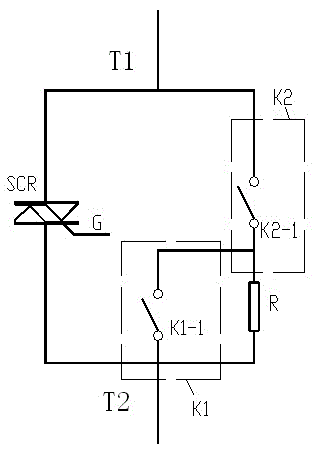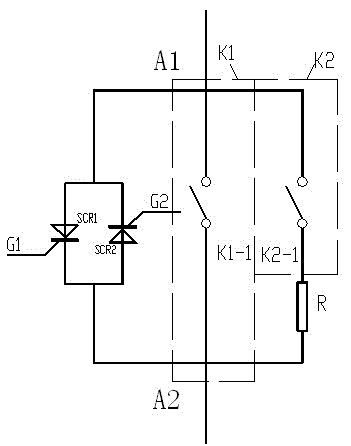Silicon controlled rectifier combination switch
A composite switch and silicon controlled rectifier technology, applied in reactive power compensation, reactive power adjustment/elimination/compensation, etc., can solve problems such as failure to meet the conduction conditions of silicon controlled rectifiers and unreliable operation
- Summary
- Abstract
- Description
- Claims
- Application Information
AI Technical Summary
Problems solved by technology
Method used
Image
Examples
Embodiment 1
[0043] like figure 1 As shown, a thyristor composite switch includes a two-way thyristor SCR and a first electromagnetic switch K1, the two-way thyristor SCR has a control terminal G and a first main terminal T1 and a second main terminal T2, and the two-way The first main terminal T1 and the second main terminal T2 of the thyristor SCR are connected in parallel with the two ends of the normally open contact K1-1 of the first electromagnetic switch K1, and also include a second electromagnetic switch K2 and a resistor R; the second electromagnetic switch The normally open contact K2-1 of the switch K2 is connected in series with the resistor R; the two ends of the series circuit composed of the normally open contact K2-1 of the second electromagnetic switch K2 and the resistor R are connected in parallel to the normally open contact of the first electromagnetic switch K1. Point K1-1 at both ends.
[0044] The first electromagnetic switch K1 and the second electromagnetic swi...
Embodiment 2
[0049] like figure 2 As shown, a thyristor composite switch includes a bidirectional thyristor SCR and a first electromagnetic switch K1, the bidirectional thyristor SCR has a control terminal G and a first main terminal T1 and a second main terminal T2, and also includes The second electromagnetic switch K2 and resistor R; the normally open contact K2-1 of the second electromagnetic switch K2 is connected in series with the resistor R; The first main terminal T1 and the second main terminal T2 of the thyristor SCR are connected in parallel; the two ends of the normally open contact K1-1 of the first electromagnetic switch K1 are connected in parallel with the two ends of the resistor R.
[0050] The first electromagnetic switch K1 and the second electromagnetic switch K2 of the present invention are relays or contactors.
[0051] Of course, the present invention preferably selects the magnetic latching relay.
[0052] When the embodiment 2 is used, the following uses the m...
Embodiment 3
[0056] like image 3 As shown, a thyristor composite switch includes two one-way thyristors SCR1, SCR2, and a first electromagnetic switch K1, and the two one-way thyristors SCR1, SCR2 respectively have a control terminal G1 and a control terminal G2, and two unidirectional thyristors SCR1 and SCR2 are connected in reverse parallel to form the first terminal A1 and the second terminal A2, and two unidirectional thyristors SCR1 and SCR2 are connected in reverse parallel and form the first terminal A1 and the second terminal A2 are connected in parallel with the two ends of the normally open contact K1-1 of the first electromagnetic switch K1, and also include a second electromagnetic switch K2 and a resistor R; the normally open contact K2- of the second electromagnetic switch K2 1 is connected in series with the resistor R; the two ends of the series circuit formed by the normally open contact K2-1 of the second electromagnetic switch K2 and the resistor R are connected in par...
PUM
 Login to View More
Login to View More Abstract
Description
Claims
Application Information
 Login to View More
Login to View More - R&D
- Intellectual Property
- Life Sciences
- Materials
- Tech Scout
- Unparalleled Data Quality
- Higher Quality Content
- 60% Fewer Hallucinations
Browse by: Latest US Patents, China's latest patents, Technical Efficacy Thesaurus, Application Domain, Technology Topic, Popular Technical Reports.
© 2025 PatSnap. All rights reserved.Legal|Privacy policy|Modern Slavery Act Transparency Statement|Sitemap|About US| Contact US: help@patsnap.com



